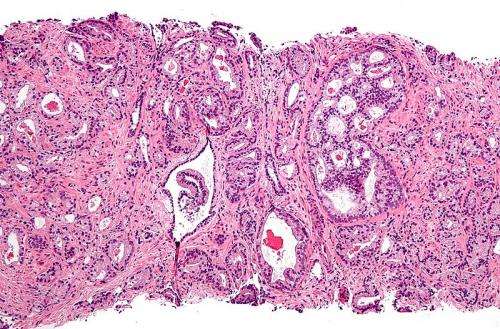Key protein in prostate cancer energy production identified

Scientists at The Wistar Institute have demonstrated how a protein called TRAP1 - an important regulator of energy production in healthy and cancerous cells - is an important driver of prostate cancer and appears to be a valuable therapeutic target for the disease. The findings were published in the Journal of Biological Chemistry.
Mitochondria are known as the powerhouse of the cells because of their role in energy production, and in recent years, research has shown that different tumors are able to manipulate genes and proteins responsible for energy production in order to help them survive.
TRAP1 is a chaperone protein that is structurally similar to heat shock protein 90 (HSP90), which is found in larger amounts in the mitochondria of cancer cells. In a prior study, Dario C. Altieri, M.D., president and CEO of The Wistar Institute, director of The Wistar Institute Cancer Center, the Robert & Penny Fox Distinguished Professor, and colleagues bred mice with the TRAP1 protein "knocked out" to determine what impact it may have on disease. These special mice lived longer and experienced fewer age-related illnesses, suggesting that the protein played an important role in disease.
"In our prior study, while we had evidence that hinted at TRAP1's role in tumor growth, we lacked the direct evidence we needed to define the role of this protein in prostate cancer development," Altieri said. "As we better understand the role of mitochondria in cancer, it's important to thoroughly study the roles of the proteins involved in helping tumors receive the energy they desire for survival."
In this study, instead of removing the TRAP1 protein, the Altieri laboratory generated mice with the TRAP1 protein overexpressed. Additionally, the mice were bred to lose one copy of the PTEN gene, which is an important tumor suppressor gene. At least one copy of PTEN is deleted in about 40 percent of cases of prostate cancer and is often found in more aggressive tumors, so mice without this gene more accurately simulate the behavior of the disease.
The combination of increased TRAP1 coupled with the loss of PTEN resulted in aggressive, early-onset invasive prostate cancer, according to the study. Altieri and colleagues found increased tumor cell proliferation, inhibition of apoptosis (a form of programmed cell death that is thought to halt the progression of tumor cells), and increased epithelial cell invasion. These findings suggest that TRAP1 has a role in promoting the mitochondrial "fitness" of a prostate tumor, making it more aggressive and less responsive to treatment.
"What is exciting about these findings is the fact that we believe TRAP1 is a druggable target," Altieri said. "We are continuing to advance our promising research and development program aimed at targeting the mitochondria in tumors."
More information: Sofia Lisanti et al, Transgenic Expression of Mitochondrial Chaperone TRAP1 Accelerates Prostate Cancer Development, Journal of Biological Chemistry (2016). DOI: 10.1074/jbc.M116.745950


















